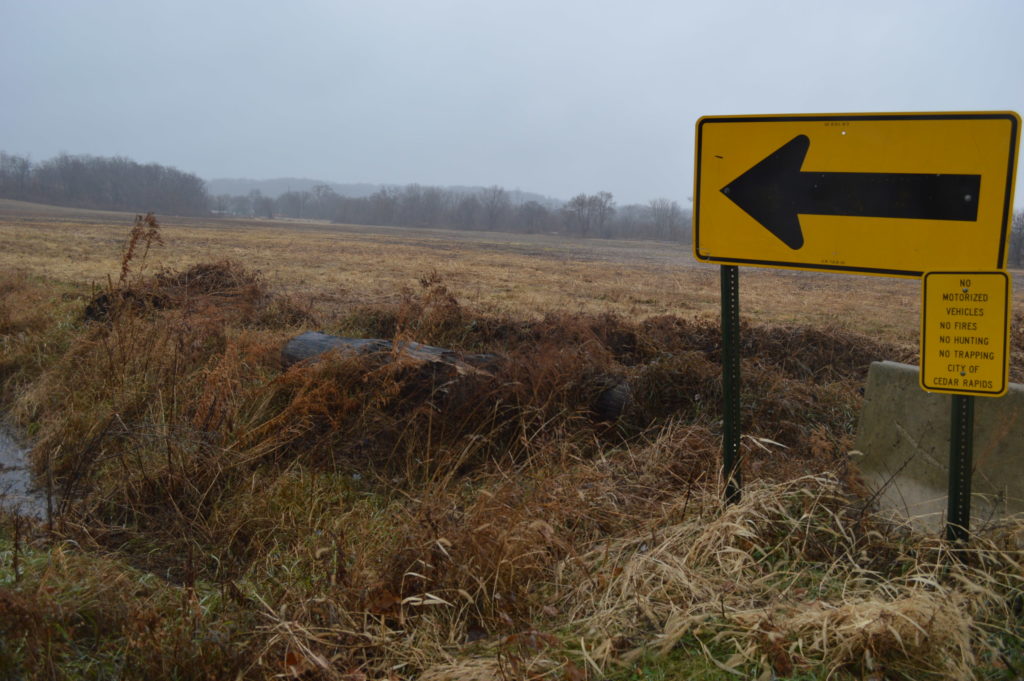
This field, formerly designated as a wildlife refuge, is where Cargill plans to build its railyard in southeast Cedar Rapids, Iowa. (photo/Cindy Hadish)
By Cindy Hadish
CEDAR RAPIDS — Ignoring concerns voiced during a nearly 4-hour meeting, the City Planning Commission sided with Cargill’s plans to build an industrial railyard in a quiet southeast Cedar Rapids neighborhood.
The commission voted 4-3 to amend the Cedar Rapids future land use map from urban low intensity to urban high intensity and to rezone the land from suburban residential large lot to general industrial.
Commission members Karl Cassell, Kim King and Virginia Wilts voted against amending the future land use map, with members Jim Halverson, Amy Homan, Daniel Seufferlein and Linda Langston in favor. Cassell, King and Langston voted against the rezoning, with Halverson, Wilts, Homan and Seufferlein approving it.
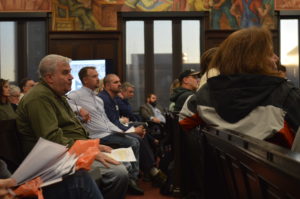
The crowd listens to speakers at the City Planning Commission meeting on Nov. 7, 2019, in Cedar Rapids, Iowa. (photo/Cindy Hadish)
Members Samantha Dahlby and Lisa Peloquin were absent.
Impassioned neighbors pleaded with the commission, as they had done in the past when the plan previously was brought up for a vote on different land in a nearby location. Under that scenario, Cargill had asked the railyard to be designated as an “essential service,” which the City Council ultimately chose to let die without a vote.
More: Brakes applied to Cargill plan
This time, Cargill was back to city-owned property where it had originally sought approval for a railyard, on a 28-acre site at Otis Avenue and Stewart Road SE, alongside the city’s popular Prairie Park Fishery — used by thousands of anglers, runners, walkers, cyclists and bird watchers — and Sac & Fox Trail in a residential neighborhood.
City staff noted that 16.7 acres would be used for the railyard, with the rest dedicated for a conservation easement that would serve as a buffer to the neighborhood, and that studies by Cargill found no wetlands on the property.
Dan Pulis, Cargill Cedar Rapids Corn Milling Facility Manager, said rail service accounts for 70 percent of their shipping needs, with trucking at 30 percent.
Pulis said plant managers have moved toward small group meetings, rather than public meetings for the neighborhood, with 100 “points of contact,” including emails, website visits and phone calls.
Neighbors, however, cited instances where they received letters from Cargill notifying them of meetings after the meetings had already taken place and having their questions about the ag giant’s project go unanswered.
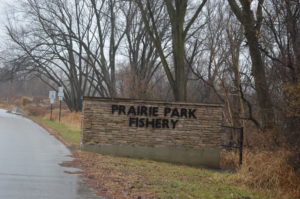
The Prairie Park Fishery, with trails used by hikers, runners and bicyclists, is next to the field where Cargill intends to build a rail yard. (photo/Cindy Hadish)
Just a handful of people spoke in favor of the railyard, including a Cargill employee and a farmer whose grain goes to the plant. Two neighbors said they welcomed the project, with one saying the proposed berm around it would hopefully slow future floods — city staff said it would not — and another saying the railyard is a better option than the drugs and other illegal activity happening at the site. He did not provide any facts to back up the claims of crime.
Nearly 20 neighbors spoke against the project, citing concerns about air, noise and water pollution, a decrease in property values — an appraisal paid for by Cargill showed no decrease — and the disruption of their quiet neighborhood with activity allowed at the railyard from 7 a.m. to 7 p.m., every day of the week.
Albert Lucas, who owns 30 acres on Otis Road SE, just across from the proposed site, said the “spot” zoning doesn’t conform with the intended use for the land.
“This city should be ashamed of themselves in being held hostage and blackmailed” by Cargill’s demands, Lucas said. “This is a residential neighborhood. It was not intended for industrial use.”
Rob Hogg, a state senator and attorney who lives on Otis Road, said he and his wife purchased their property in 1999 after carefully scrutinizing the land use plans for the area.
“We relied on that to decide to invest in our future in Cedar Rapids,” Hogg said. “I believe putting an industrial intrusion into this neighborhood is a betrayal of the promise that you made to me and my wife and our family.” (See Hogg’s letter to the commission, below.)
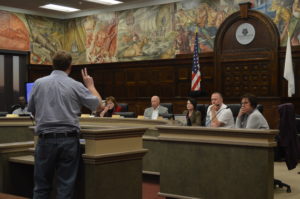
State Senator Rob Hogg, who lives near the proposed site, speaks in front of the commission. (photo/Cindy Hadish)
Angela Gillis, who has lived in the neighborhood for 25 years, said the city’s process favors corporate applicants, with staff offering their time and suggestions to make the plan favorable “if it’s not going in their direction.”
“I’m limited to 5 minutes today,” she said of her time allowed to speak to the commission. “It seems very unfair to the residents.”
The commission’s Cassell said he’d prefer to err on the side of caution before subjecting residents to potential pollutant risks.
“I need something more to convince me that this is a good idea,” he said.
The commission’s recommendation next goes to the City Council, with a public hearing set for Tuesday, Nov. 19. Even before hearing from either side, some council members have indicated they would approve Cargill’s plan.
“To say they would vote for it before they hear from any of us,” said Kerry Sanders, who lives near the proposed site, “that is corruption at its core.”
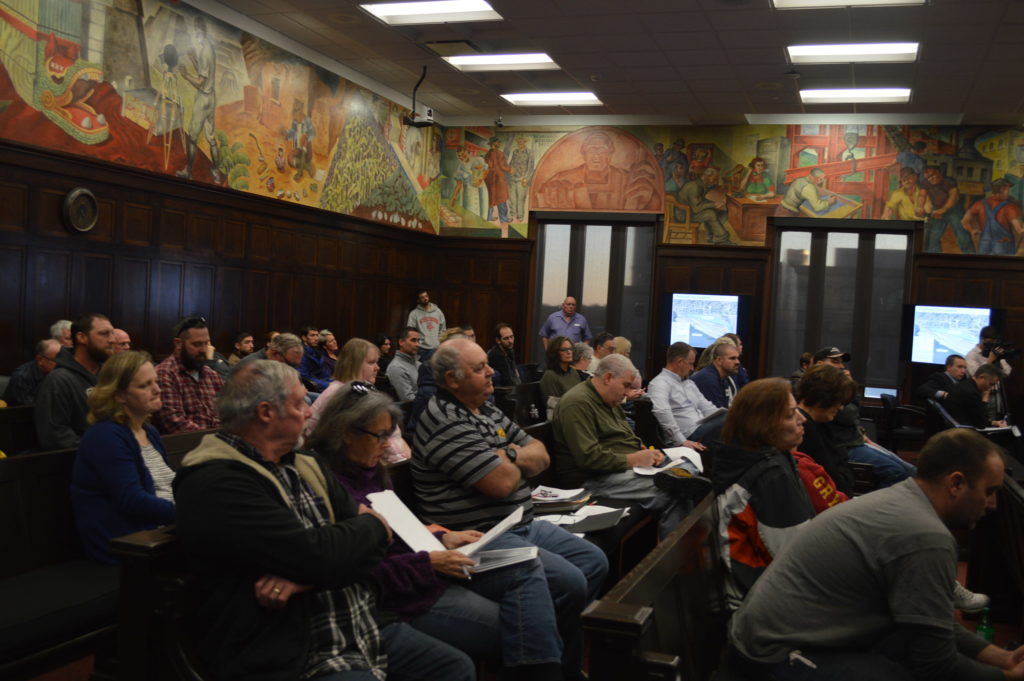
Dozens of residents sat through hours of the City Planning Commission meeting as members decided on Cargill’s plans for a railyard in their neighborhood in southeast Cedar Rapids. (photo/Cindy Hadish)
Letter from Rob Hogg to the Cedar Rapids City Planning Commission:
November 6, 2019
City Planning Commission Members
Cedar Rapids, IA 52401
Dear Commission Members:
I am writing to you to oppose the application for the amendment to the future land use plan and the re-zoning of the existing city-owned land bounded by Otis Avenue SE, Cole Street SE, and the rail spur line adjacent to the Prairie Park Fishery, for the purpose of construction of a rail yard by Cargill.
Currently, the land at issue is used as park land, a pollinator zone, and open space. Before and during the 20 years our family has lived at our home on Otis Road, this land has been held out to the public as a park, as a wildlife refuge, and as a pollinator protection area. The neighborhood as a whole has been zoned agricultural, residential, and park and open space. The Prairie Park Fishery was added in 2010, continuing to build on the city’s commitment to a greenbelt along the river.
I share this background because there is not a single person who bought a property or lives in this neighborhood who did so expecting to live near a rail yard. My wife and I never expected a rail yard in our neighborhood. When we bought our house in 1999, we looked into the land use plans before buying our house and property. The land use plans at the time showed farms, homes, parks and trails. The comprehensive land use plan today says this land should be urban low density. To allow an industrial use of this land would be a betrayal of the city’s promises to us in those land use plans.
Land use plans are comparable to property rights, like nuisance law is a property right. To change a zoning designation, there must be “changing conditions” to justify the change. Little v. Winborn, 518 N.W.2d 384, 387; Webb v. Giltner, 468 N.W.2d 838, 840 (Iowa Ct. App. 1991) (citations and quotations omitted).
In this case, nothing has changed to justify the proposed rezoning or the amendment to the future land use map.
Cargill has an industrial plant over a mile upriver at 1710 16th Street SE where it has been located for many years. Nothing has changed there that justifies rezoning over a mile away.
Cargill’s plant is connected to a common carrier, a railroad, just like it has been connected to a common carrier for many years. Again, there has been no change that justifies rezoning.
The Rompot neighborhood continues to be a modest, working family neighborhood, just like it was when we bought our property in 1999. Again, there has been no change in circumstances that would justify rezoning. One of the guiding principles of the city’s comprehensive plan, EnVision CR, is to “strengthen neighborhoods,” and the plan specifically states on page 49, “Cedar Rapids should maintain zoning and land use policies that protect the integrity of its neighborhoods.”
The addition of the Prairie Park Fishery in 2010 does not justify rezoning for an industrial use. To the contrary, that new park calls out for protection from industrial uses. As the city’s comprehensive plan EnVision CR states on page 33, the city should “[b]uffer and connect existing parks, trails, and streams to build a natural network in addition to regional collaborations and individual efforts to improve stormwater management, water quality, wildlife habitat, and outdoor recreation.”
The Flood of 2008 does not justify rezoning for an industrial use. To the contrary, the flood calls out for protection of the flood plain from industrial development. As the City’s comprehensive plan EnVision CR states on page 26, “A post-flood Cedar Rapids has already made great strides in embracing its natural systems. Relatively recent studies speak to the value of environmentally sensitive areas and large tracts of habitat to support diverse plants and wildlife. Residents need nature integrated into daily living for physical and mental health. The riverfront greenway is just one piece of a community seeking at every turn to make its mark in the arena of sustainability.”
What we should be doing with this city-owned park, open space, and pollinator land – land that was inundated during the 2008 flood – is preserving it, protecting it, and potentially enhancing it with wetland restoration and other natural solutions to flooding.
This is particularly important because the Rompot neighborhood has been left out of the city’s flood protection system. At taxpayer expense, we are building a flood protection system for other riverfront neighborhoods. I support their protection. At taxpayer expense, we are building a flood protection system for Cargill’s industrial plants. I support their protection.
But now – after being left out of the flood protection system – the Rompot neighborhood is being asked to not only help pay for a flood protection system that doesn’t protect us, but also to “take one for the team” by taking an industrial rail yard in our modest, working family neighborhood.
The “change” that allegedly justifies this industrial intrusion into the Rompot neighborhood and the Cedar Rapids greenbelt is that Cargill and the Union Pacific can’t agree on how to get enough cars to Cargill, even though they have used those rail facilities for years to get rail cars to Cargill. That doesn’t justify rezoning. That is a problem that should be resolved by Cargill and the Union Pacific, not dumped into the Rompot neighborhood or the Prairie Park Fishery or the Cedar Rapids greenbelt.
I do not believe that changes in a railroad-customer relationship are legally sufficient to justify rezoning. Why not? Because the railroad is a common carrier subject to federal regulation. If the Union Pacific and Cargill can’t agree, they can and should take it to the federal Surface Transportation Board.
For those of you not familiar with the Surface Transportation Board, that is the federal agency with “jurisdiction over railroad rate and service issues.” (https://www.stb.gov/stb/about/overview.html) Cargill knows how to file complaints before the Surface Transportation Board and has on many occasions. The rail provisions are set out in 49 U.S.C. sections 10101-11908. Sections 10701 through 10709 provide the STB with regulatory authority over railroad practices, services, and contracts. Section 10722 provides for “premium contracts” with customers. If Cargill and the Union Pacific can’t agree on how to get enough rail cars, they should go to the Surface Transportation Board to resolve the problem.
In summary, there are no “changing conditions” that justify this rezoning, and it would be fundamentally unfair to residents of Cedar Rapids like my family who have invested and made life decisions in reliance on the city’s land use plans to change the land use map and the zoning of the city’s property.
If you choose to recommend approval of these changes, if you decide that we really weren’t entitled to rely on the city’s land use plans, and if the city council then decides to force this industrial use into our neighborhood, let me suggest the city owes our neighborhood a lot more than is being done in the weak conditions set out in the staff’s proposal.
The proposal is for a 12-track, 200-car rail yard that will operate 12 hours a day, 365 days a year, and bring significant increased rail traffic, noise, light, and other industrial problems to our whole neighborhood, not just people within sight of the rail yard. If the city decides to put that industrial use into our neighborhood, here are five additional conditions I believe you should recommend and the city council should approve:
1. Require electric locomotives to reduce or eliminate noise, fumes, and diesel fuel use in the neighborhood – if this rail yard is going to be built in an existing residential neighborhood, it should be the cleanest and most advanced rail yard in the country.
2. Add buffering between the rail yard and the Prairie Park Fishery so the industrial use does not detract as much from the use and enjoyment of the park.
3. Offset the loss of natural habitat by adding at least the same amount of land for restored habitat nearby for public use and enjoyment and maintenance of natural systems.
4. Create a significant monetary fund for buy-outs, relocations, soundproofing, and maintaining home values near the rail yard and along the rail line – we didn’t choose to live near a rail yard, and we didn’t want the threat to the enjoyment of our property and our ability to re-sell our properties, so provide money to help neighbors protect ourselves and our property. The city’s comprehensive plan on page 49 says that the city favors “preservation of existing neighborhoods and housing stock” as the “most cost-effective ways to assuring a continued supply of good housing” – show us that you mean it.
5. Require financial assurance by Cargill for decommissioning the rail yard and restoring the property to a natural state for the eventuality that the Cargill industrial plant closes or the rail yard floods.
Please reject the proposed rezoning and amendment to the land use map. If you do recommend it, show us you care about this neighborhood and your fellow Cedar Rapids residents by adding the conditions I have suggested above, and other conditions suggested by the public that would strengthen the neighborhood, reduce flood risk, and improve and connect our parks and natural areas.
Sincerely,
Robert M. Hogg

Thanks, Cindy. That was my first time attending a Planning Commission meeting. It didn’t seem as if (almost) 4 hours had passed, likely because of the emotions expressed. (And the consequences of a majority “yes” vote.) I’m glad you included Senator Hogg’s letter since it was referenced more than once.